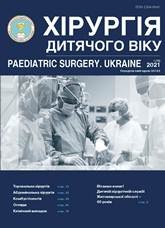Experience in the treatment of early neonatal parasitic sepsis in the maternity hospital
DOI:
https://doi.org/10.15574/PS.2021.70.90Keywords:
newborn, intrauterine, parasitic sepsis, chlamydia, toxoplasmosisAbstract
Early neonatal sepsis mainly has bacterial etiology – 84%, less often fungal – 12%, otherwise – viral and parasitic etiology. According to the European Center for Disease Control and Prevention (CDC), the occurrence of sepsis in newborns is closely related to birth weight and gestational age, as well as skin color. It was established, in particular, that the most severe types of sepsis occur in children weighing 400–1500 g at birth and less than 30 weeks of gestation. Parasitic sepsis in newborns refers to severe forms of childhood sepsis, with mortality reaching high. The article presents the experience of successful treatment of 2 newborns in a maternity hospital both were non-transportable. At the beginning of treatment, the anamnesis of pregnancy was thoroughly studied. From the first day of the disease, both patients underwent a comprehensive instrumental (ultrasound, X-ray) and laboratory (PCR, ELISA, procalcitonin, coagulogram, CRP and general biochemistry tests) examinations. One child – prematurely born at 30 weeks of gestation with a weight of 1070 grams – was treated for intrauterine chlamydial sepsis. The second suffered from intrauterine toxoplasmotic sepsis and Rhconflict; the latter was treated in utero at 30 weeks of gestation. Both patients were treated by a multidisciplinary team and the children recovered.
Conclusions. The results of treatment show effectiveness pathogen approach to the treatment of severe sepsis in newborns.
The research was carried out in accordance with the principles of the Declaration of Helsinki. The permission of the parents of the children was obtained to conduct the research.
The authors declare no conflicts of interest.
References
Angus Derek. (2012). Sepsis in the developing world: lessons for a small planet. Speaker abstracts. Paris. Sepsis: 11.
ChavezBueno S, Mc Culloh RJ. (2018). Current Trends in Epidimiology and Antimicrobial Resistans in Epimiology and Antimicrobial Resistance in Neonatal Sepsis. JeanLouis Vincent Editor. Annual Update in Intensive Care and Emergency Medicine: 39–52. https://doi.org/10.1007/978-3-319-73670-9_4
Khanes GS, Maksakova IS, Liutko OB. Mitiakina IYu, Horelik VV. (2019). Diagnostic and treatment of bone and joint sepsis in newborns. Collection of Science works. Innovations technology in Pediatric surgery and Intensive Care. Kyiv: 66–67.
Khanes GS. (2012). Questions of pathofisiology and diagnostic of pediatric sepsis. Sbornic publication. 8th annual. Moskovskaya conference «Gnoino-septicheskie zabolevania u detey» Russian and SNG countri’s: 60–63.
Koltsova IG, Trubina LM, Tishechkina VO, Zubkova IN, Mischenko VP, Davidovich FD. (2003). Role of toxaplosmosis in occurrence of a pathology in pregnant and fetus. Pediatric, Obstetric and Gynecology. 3: 79–83.
Moore SW, Wright C. (2011). The Role of antenatal placental infections in Necrotizing Enterocolitis (NEC) – A Pilot study. Abstract of 9th PAPSA Сeip-Town. Biennale Conference: 17.
Randolf AG. (2018, Oct 1). Sepsis in Children. Sepsis 2018. Speaker abstract: 24.
Zaplatnikov AL, Korovina NA, Korneva MYu, Chebukin AV. (2013). Russian Medical Academy of Postgraduate Education. Intrauterin infection: diagnosis, treatment, prevention. Emergency Medicine. 1 (48): 25–33.
Downloads
Published
Issue
Section
License
The policy of the Journal “PAEDIATRIC SURGERY. UKRAINE” is compatible with the vast majority of funders' of open access and self-archiving policies. The journal provides immediate open access route being convinced that everyone – not only scientists - can benefit from research results, and publishes articles exclusively under open access distribution, with a Creative Commons Attribution-Noncommercial 4.0 international license(СС BY-NC).
Authors transfer the copyright to the Journal “PAEDIATRIC SURGERY.UKRAINE” when the manuscript is accepted for publication. Authors declare that this manuscript has not been published nor is under simultaneous consideration for publication elsewhere. After publication, the articles become freely available on-line to the public.
Readers have the right to use, distribute, and reproduce articles in any medium, provided the articles and the journal are properly cited.
The use of published materials for commercial purposes is strongly prohibited.

